Making 'Mystere'
Story by David Mirhadi | Photos by John Gurzinski
Tuesday, August 22, 2000 | Copyright © Las Vegas Review-Journal
It's three hours before showtime on a Wednesday, and
director Joe Walsh is shouting above the din created by the trapeze artists, acrobats and
dancers in Cirque du Soleil's "Mystere," just loud enough to ensure everyone knows he wants
the 3,118th show to go off smoothly.
It's rehearsal, or
"training day," for the 139-member Cirque du Soleil cast and crew at Treasure Island. At this
hour, members of the 10-piece orchestra are jamming in their perch above the stage and a pair
of young gymnasts are practicing a balancing act on a 300-pound wooden ball that measures 8
feet in diameter.
Meanwhile, the 44-member backstage crew is
busy dusting the high bars with chalk, tightening rope nets to catch those who
might fall, and checking the multilevel stage that rises and sinks below the floor several
times during the course of the 90-minute performance.
In several dressing rooms in the depths of
the showroom, hairdressers and seamstresses frantically stitch, glue and patch
some of the more than 10,000 shirts, wigs, hats, dresses, pants and gloves used
in the French-Canadian show that, after 6 1/2 years, is one of the Strip's most popular productions.
Like in most other shows, the crew members who keep the
animal-free nouvelle circus going are never seen by the audiences that fill the 1,541-seat theater.
Assembling "Mystere" -- which is described by Walsh as "a funny,
simple, astonishing show about life" -- is a process that's part physical effort and part high
technology. Stagehands organize much of the show before it begins with such chores as raising
and lowering the trapezes from the ceiling and testing the smoke machine for kinks. Once the
curtain rises, however, computers take over most of the lighting and special effects.
Backstage before the recent show, Jack Ricks, wardrobe
head for "Mystere," is dashing around the main dressing room, checking on seamstresses
stitching headpieces together. The room is studded with spools of yarn, boxes of zippers,
costume scraps, and soiled and ripped outfits ready to be fixed or cleaned.
"Costuming in general is labor-intensive," Ricks said.
Is it stressful?
"Yes, but it's fun to have a little bit of pressure.
It's a fun job ... one of those that you say `I get paid for this?' " said Liann Wojtowitz,
a craft technician who has been on the job for five years.
"After this many years, it's not frantic," Ricks said.
"It's our objective to have this show go off like clockwork. Our goal is not to have any
mishaps. It's always nice, though, working in a show that has a measure of energy."
While much of the show is put in place before the
curtain ever rises, some physical and mechanical work, both simple and complex, is required
while the show runs.
One of the simplest tasks involves moving a pair of
baby carriages around the stage during the opening act. Two lighted baby carriages,
which are used in a scene that involves a ventriloquist and his wisecracking dummy, are
moved about the stage by a pair of stagehands who run underneath the stage, carrying
ropes that are attached to the carriages.
In the closing scene, a huge snail, symbolizing
the pace of life in the grand scheme of things, is inflated below the stage with huge
blowers. The snail, made of cotton, rises from below the stage on a rotating axis.
The snail's eyes, which remained closed for much of
the show's early life, now blink at several intervals during the finale. A rather
pedestrian innovation enabled this improvement, said Nancy Mallette, "Mystere" production manager.
A series of cables, akin to bicycle hand brakes, are pressed
together by a member of the crew who is inside the snail. When pressed, the snail's eyes close.
"That's a small, very fine-tuning item, but it's very
important to us," Mallette said. "It's a simple solution. Old theater tricks are extremely useful."
Another simple innovation involves an act called "The Cube," in
which acrobat Paul Bowler soars over the stage and part of the audience and spins in a steel cube.
At one point, the cube is spinning so fast it appears as if it has become a laser. It's really just
different colors of light shining on the cube that create the effect, said Eric Heppell, artistic
coordinator for "Mystere."
"None of the artists feel the effects of computerization,"
Heppell said. "The machinery is (used) to service the artistry. It allows us to have a show that
even though there are things moving, you never see the technology. It never interferes with
what the people are seeing. As an audience member, you don't have to pay attention to that.
You just concentrate on the performance."
But in truth, "Mystere" is as complex as it is simple,
Walsh said. For without technological innovation, the seemingly vaudevillian show that
people see from their seats would never materialize.
Two computers in the director's booth run everything
from lighting to operating the stages, such as lowering a catwalk that serves as a perch
for Francois Dupuis during a scene in which Dupuis' character, an oversized tot, finds he's
literally living life on the edge of the narrow platform.
"In this show, you have one person doing many
individual things. ... Your lighting has to focus on many different angles, many different
aspects of the show," said lighting director Tommy Hanlon, who has done similar work in the
Golden Nugget's former showroom.
"This is not a one-button show," Hanlon continued,
referring to some shows on the Strip that are entirely computerized. "That doesn't work
in this show at all."
The control-booth team consists of Hanlon, Walsh and four
technicians who work the sound and lighting boards. Two cameras perched in the control booth
project pictures on the back wall of the stage during part of the show.
Computers track the "robotic lights" that
follow a performer onstage. The motorized multilevel stage is raised and lowered
automatically, as are the trapezes in a bungee act, which consists of performers
twisting and turning while being harnessed to spring-loaded cords. The entire act is
choreographed from the director's booth.
Those in the control booth have the easy job, Walsh admitted.
"You're asking people, even those in peak physical condition,
to put themselves in a position of tension," he said. "No one gets bored here, that's for sure."
It also is a show of contrasts, he added.
"There's a lot of individuality and flexibility to
this show," Walsh said. "It's always changing. This show is not about large set pieces. It's about humanity."
Heppell, the artistic coordinator and Walsh's second-in-command,
agreed. "That's the golden rule of this show -- that it's a work in progress. The show may change, but
the philosophy remains the same. We're not in the era yet that a show like this could be done with robots
and computer-generated graphics. It's real, about people.
"I don't know what people will want to see in the
future," added Heppell, a German gymnast who joined Cirque du Soleil several years ago,
"but the only way I think people will lose interest in this show is if they lose interest in quality."
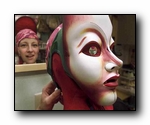
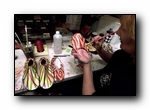
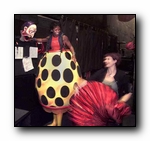
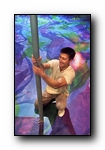
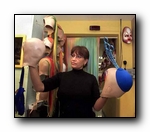
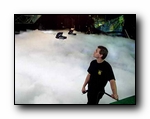
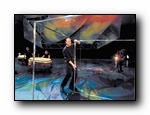
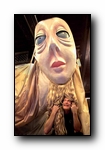
|

![]()









